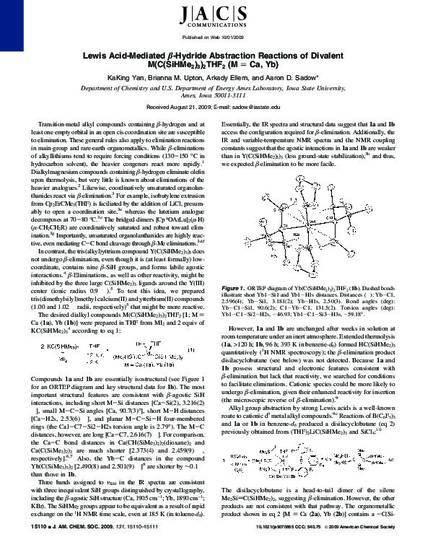
The divalent calcium and ytterbium compounds M(C(SiHMe2)3)2THF2 contain β-agostic SiH groups, as determined by spectroscopy and crystallography. Upon thermolysis, HC(SiHMe2)3is formed. However, the SiH groups are hydridic. The compounds M(C(SiHMe2)3)2THF2 react with 1 and 2 equiv of the Lewis acid B(C6F5)3 to form MC(SiHMe2)3HB(C6F5)3)THF2 and M(HB(C6F5)3)2THF2, respectively. These species contain the anion [HB(C6F5)3]− from hydride abstraction rather than [(Me2HSi)3CB(C6F5)3]− from alkyl abstraction. The 1,3-disilacyclobutane byproduct initially suggested β-elimination [as the dimer of the silene Me2Si═C(SiHMe2)2], but the other products and reaction stoichiometry rule out that pathway. Additionally, Yb(C(SiHMe2)3)2THF2 and the weak Lewis acid BPh3 react rapidly and also give the H-abstracted products. Despite the strong hydridic character of the SiH groups and the low-coordinate, Lewis acidic metal center in M(C(SiHMe2)3THF2 compounds, β-elimination is not an observed reaction pathway.
Available at: http://works.bepress.com/aaron_sadow/4/

Reprinted (adapted) with permission from Journal of the American Chemical Society 131 (2009): 15110, doi: 10.1021/ja9070865. Copyright 2009 American Chemical Society.